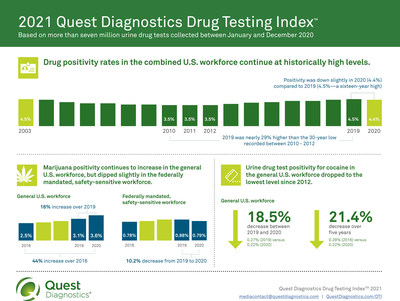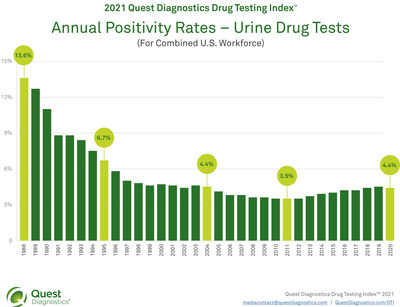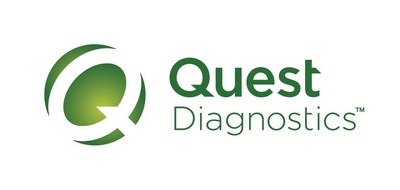Marijuana Workforce Drug Test Positivity Continues Double-Digit Increases to Keep Overall Drug Positivity Rates at Historically High Levels, Finds Latest Quest Diagnostics Drug Testing Index™ Analysis
The Quest Diagnostics Drug Testing Index™ reveals that marijuana positivity rates in the general U.S. workforce rose to 5.5% in 2020, a 3.8% increase from 2019. This marks a significant trend amid the COVID-19 pandemic, where overall positivity slightly declined from 4.5% in 2019 to 4.4% in 2020. In federally mandated sectors, positivity decreased by 8.3%. Notably, positivity for cocaine hit the lowest level since 2012. The findings highlight the importance of workplace drug testing as hiring increases.
- Marijuana positivity in the general U.S. workforce rose to 5.5%, a 3.8% increase from 2019.
- Cocaine positivity rates fell to the lowest since 2012, indicating a positive trend in drug testing.
- Overall drug positivity slightly declined in 2020, providing a more favorable environment for employers.
- Positivity rates in federally mandated sectors fell by 8.3%, showing a concerning trend in safety-sensitive areas.
- Despite the overall decline in positivity, marijuana positivity continued to rise, signaling potential workplace safety issues.
Insights
Analyzing...
SECAUCUS, N.J., May 26, 2021 /PRNewswire/ -- The COVID-19 pandemic did not dampen workforce drug testing positivity for marijuana, which continued to increase last year in the general U.S. workforce, according to a new analysis released today by Quest Diagnostics (NYSE: DGX), the world's leading provider of diagnostic information services. This study is thought to be the first large-scale analysis of de-identified results of laboratory workforce drug tests performed during the COVID-19 pandemic.
The overall positivity rate in the combined U.S. workforce based on more than seven million urine drug tests collected between January and December 2020 was down only slightly in 2020 (
As positivity for most drug categories, other than marijuana, declined or remained flat in the combined U.S. workforce over the past five years, amphetamines (which includes methamphetamine) persisted at 1.1 percent positive each year.
The new findings of the Quest Diagnostics Drug Testing Index™ were unveiled to coincide with the National Drug & Alcohol Screening Association (NDASA) 2021 Annual Conference taking place May 25-27 in St. Louis, MO.
"Driven largely by surging rates of marijuana general U.S. workforce positives and steady rates of amphetamines positives, the rate of drug positivity remained stubbornly high despite seismic shifts to the workplace caused by the COVID-19 pandemic," said Barry Sample, Ph.D., senior director of science and technology, Quest Diagnostics. "However, as we see upticks in hiring and many employees returning to the workplace, it is important that employers consider workforce drug testing as a way to keep the workplace, their customers and the community safe."
"Impairment, whether it be by drugs, alcohol, fatigue or stress, decreases the safety of the workforce," said Jenny Burke, senior director of impairment practice, National Safety Council. "The DTI results, reflecting decreases in many drug categories, occurred in a unique year. Even though these are down, we must continue to educate people about the impairing impacts of these substances. And, as states and the federal government consider changes to the legality of marijuana, we can't take for granted that they also understand the impairing impact of THC. The safety of people who share the roadways and workplaces with impaired people needs to be a priority."
For an interactive map with positivity rates and trend lines by three-digit zip code in the United States, visit DTIDrugMap.com.
Positivity down or flat for most drug categories, but increase for ecstasy
Urine drug test results in the general U.S. workforce declined in eight drug categories but stayed the same in two drug categories (excluding propoxyphene, which was withdrawn from the U.S. market a decade ago). Positivity for cocaine declined 18.5 percent (
Positivity rates declined in federally mandated, safety-sensitive workforce testing categories
Urine drug test results for the federally mandated, safety-sensitive workforce declined in all drug categories other than phencyclidine (PCP), which remained at 0.011 percent, same as in 2019. Of note, positivity for marijuana declined 10.2 percent (
Marijuana continued double-digit year-over-year increases in the general U.S. workforce, with lower positivity rates in states with only medical marijuana use or no form of legalized marijuana use versus states with legalized recreational statutes
Marijuana positivity surged ahead in 2020 in the U.S. general workforce and across specimen types (urine, oral fluid, and hair). In the U.S. general workforce, marijuana positivity increased 16.1 percent in urine testing (
The Drug Testing Index data also showed stark differences between states that have legalized recreational marijuana use versus states that have only legalized medical marijuana use or no form of legal marijuana use. Marijuana positivity surged in states with legal recreational use statutes 118.2 percent from 2012-2020 (
"Our data suggest that marijuana positivity has increased sharply nationwide since states began to legalize marijuana in 2012. However, it appears that states where medical marijuana use alone is legal are not experiencing much higher rates of increase than states where neither medical nor recreational use is legal," Dr. Sample said.
The positivity rate of post-accident test results grew faster than the rate of positivity for pre-employment testing
Between 2012, when the first state legalized recreational marijuana, and 2020, the gap between pre-employment and post-accident marijuana positivity increased each year. In the U.S. general workforce, in 2012, marijuana pre-employment positivity was 1.9 percent and post-accident positivity was 2.4 percent (a
"The Drug Testing Index data shows states with recreational marijuana statutes have significantly higher positivity and the year-over-year differences between recreational states and states with medical and no legalization statutes has grown. In addition, while urine drug testing cannot determine whether an individual is under the influence or impaired at the time of test, our post-accident data suggests that marijuana use may play a role in those workplace incidents prompting a drug test," Dr. Sample said.
Cocaine positivity lowest since 2012 general U.S. workforce
Urine drug test positivity for cocaine in the general U.S. workforce dropped to the lowest level since 2012. Positivity for cocaine declined 18.5 percent (
Workforce positivity increased significantly in multiple industries
The Quest Diagnostics Drug Testing Index™ Industry Insights of general U.S. workforce positivity rates, based on more than 17 million urine drug test results between 2016 and 2020, shows year-over-year increases in overall workplace drug positivity in 6 of the 17 sectors reported. The Retail Trade industry had the highest overall positivity rates for all drug categories across all five years of the analysis (
Workforce Drug Testing Webinar
Barry Sample, PhD, senior director of science and technology, for Quest Diagnostics, will discuss the latest data from the Drug Testing Index and an analysis of workforce marijuana testing via webinar on Wednesday, June 16 at 12 pm EDT/11 am CDT. Click here to register and attend.
About the Quest Diagnostics Drug Testing Index™
The Quest Diagnostics Drug Testing Index™ (DTI) is a series of reports that provide insights into trends in workforce drug use based on positivity rates of de-identified laboratory tests performed by Quest Diagnostics for a range of illicit, legal and prescription drugs. It examines test results according to three categories of workers: federally mandated, safety-sensitive workers; the general workforce; and the combined U.S. workforce. Federally mandated, safety-sensitive workers include pilots, bus and truck drivers, and workers in nuclear power plants, for whom routine drug testing is mandated by the U.S. Department of Health and Human Services.
The strengths of the DTI analysis include its large, nationally representative sample size, longitudinal monitoring, a testing population that is generally reflective of the U.S. workforce and the quality of the company's drug testing services to confirm positive results. Limitations include analysis only of employers that perform drug testing with the company, and a lack of exact cross-specimen comparisons due to variations in substances for which employers test. Additionally, COVID-19 and regulatory changes may have also impacted hiring and the way in which employers tested – for example, in 2020 for the federally mandated safety-sensitive workforce, the percentage of specimens tested for pre-employment purposes declined while those for random tests increased. Quest Diagnostics has analyzed annual workplace drug testing data since 1988 and publishes the findings as a public service.
In addition to workplace drug testing, Quest is a leader in clinician-ordered drug testing services through its Clinical Drug Monitoring program to aid the detection of potentially dangerous forms of prescription and illicit drug use. For more information on Quest's drug monitoring services for healthcare providers, visit QuestDrugMonitoring.com
About Quest Diagnostics
Quest Diagnostics empowers people to take action to improve health outcomes. Derived from the world's largest database of clinical lab results, our diagnostic insights reveal new avenues to identify and treat disease, inspire healthy behaviors and improve health care management. Quest annually serves one in three adult Americans and half the physicians and hospitals in the United States. Our 50,000 employees understand that, in the right hands and with the right context, our diagnostic insights can inspire actions that transform lives. www.QuestDiagnostics.com.
![]() View original content to download multimedia:http://www.prnewswire.com/news-releases/marijuana-workforce-drug-test-positivity-continues-double-digit-increases-to-keep-overall-drug-positivity-rates-at-historically-high-levels-finds-latest-quest-diagnostics-drug-testing-index-analysis-301299762.html
View original content to download multimedia:http://www.prnewswire.com/news-releases/marijuana-workforce-drug-test-positivity-continues-double-digit-increases-to-keep-overall-drug-positivity-rates-at-historically-high-levels-finds-latest-quest-diagnostics-drug-testing-index-analysis-301299762.html
SOURCE Quest Diagnostics











